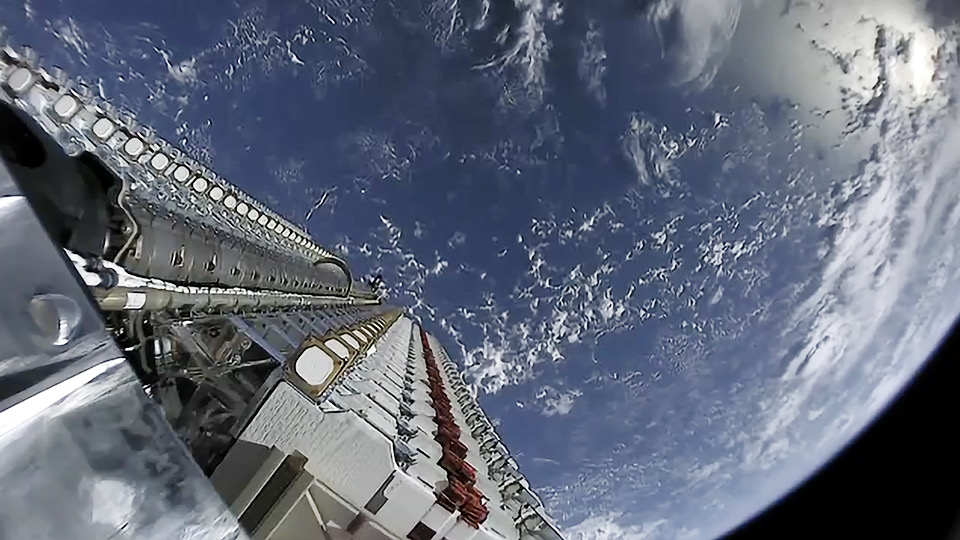SpaceX Test-Fires Rocket for Next Launch of 60 Starlink Satellites

CAPE CANAVERAL, Fla. — SpaceX has fired up the rocket booster that will ferry the company's next batch of Starlink satellites into space.
The company conducted a static-fire test on Tuesday (Nov. 5) of a Falcon 9 rocket at Space Launch Complex 40 at Cape Canaveral Air Force Station in Florida, the company said on Twitter. That rocket is expected to send 60 Starlink internet satellites into space no earlier than Monday (Nov. 11), ending a nearly three-month launch hiatus for the company.
The last time a SpaceX Falcon 9 took to the skies, it carried the Israeli AMOS-17 communications satellite on Aug. 6. Now, the company will return to loft a second batch of Starlink satellites, after a prototype set launched in May. The company is also using the flight to target several reusability milestones.
Related: SpaceX's 1st Starlink Megaconstellation Launch in Photos!
Next week's flight will mark the first time that SpaceX has flown the same Falcon 9 first-stage booster four times. This particular booster, dubbed B1048.4 by the company, first flew more than a year ago. On July 25, 2018, it carried a batch of Iridium satellites into orbit; on Oct. 8, 2018, it lofted the Argentinian Earth-observing satellite SAOCOM 1-A, and on Feb. 22, it ferried the Nusantara Satu Indonesian communications satellite and the Israeli Beresheet lunar lander into space.
In addition, during the upcoming Starlink launch, SpaceX will attempt to reuse a payload fairing for the first time. Also known as the rocket's nose cone, the payload fairing shields the rocket's contents as it travels through the atmosphere.
SpaceX's philosophy has always been that a fully (and rapidly) reusable rocket is the key to dramatically reducing the cost of spaceflight. Currently, a Falcon 9 launch costs around $62 million. Although SpaceX has proved it can reuse the most expensive portion of the rocket, the first stage, the company would like to reuse much more, essentially making fuel the only major expense.
Get the Space.com Newsletter
Breaking space news, the latest updates on rocket launches, skywatching events and more!
The fairing supporting this mission previously flew on Falcon Heavy’s Arabsat-6A mission pic.twitter.com/iTgqqtl1pWNovember 5, 2019
To that end, SpaceX has transformed two ships into mobile catcher's mitts, each outfitted with four arms and a giant net strung in between to attempt to catch the fairing halves as they fall back to Earth. Saltwater is extremely corrosive, so keeping the fairing halves dry, rather than letting them splash down in the Atlantic Ocean, is crucial to reuse.
SpaceX uses identical fairings for its Falcon 9 and Falcon Heavy rockets. Each one costs about $6 million, so there's a significant financial incentive to recover and reuse the fairings. SpaceX fairings are composed of two halves, each of which is equipped with small steering thrusters and parachute-like equipment to aid in recovery efforts.
SpaceX's first successful catch came in June during a Falcon Heavy launch, when one half of the rocket's nose cone glided into the outstretched arms of the boat GO Ms. Tree (formerly known as Mr. Steven).
Related: SpaceX's Fairing-Catching Boat in Photos
But that isn't the fairing that will fly again. On Monday, SpaceX will attempt to reuse a fairing recovered from the Atlantic Ocean back in April after they helped a Falcon Heavy deliver the Arabsat-6A communications satellite into space. SpaceX did not specify what sort of refurbishments the fairing halves have gone through.
On board next week's rocket will be SpaceX's second batch of 60 experimental Starlink satellites designed to provide internet access. The company launched a first group of 60 in May and plans for its burgeoning constellation to eventually be more than 40,000 satellites strong, according to recent filings.
The initial Starlink plan called for a megaconstellation of 12,000 satellites. But SpaceX recently filed paperwork with the International Telecommunication Union, a United Nations agency that manages the global satellite radio-frequency spectrum, to launch another 30,000 satellites.
Company CEO Elon Musk has said SpaceX will need at least 400 Starlink satellites in orbit for "minor" broadband coverage, and 800 satellites aloft for "moderate" coverage.
Last month, Musk tweeted via Starlink for the first time. And with as few as six to eight more launches, the company says it could begin offering broadband service in the United States by mid-2020.
- SpaceX's Starlink Constellation Could Swell by 30,000 More Satellites
- SpaceX's Starlink Broadband Service Will Begin in 2020: Report
- 'Whoa, It Worked': Elon Musk Tweets Via SpaceX's Starlink Satellites
Follow Amy Thompson on Twitter @astrogingersnap. Follow us on Twitter @Spacedotcom or Facebook.

Join our Space Forums to keep talking space on the latest missions, night sky and more! And if you have a news tip, correction or comment, let us know at: community@space.com.

Amy Thompson is a Florida-based space and science journalist, who joined Space.com as a contributing writer in 2015. She's passionate about all things space and is a huge science and science-fiction geek. Star Wars is her favorite fandom, with that sassy little droid, R2D2 being her favorite. She studied science at the University of Florida, earning a degree in microbiology. Her work has also been published in Newsweek, VICE, Smithsonian, and many more. Now she chases rockets, writing about launches, commercial space, space station science, and everything in between.









